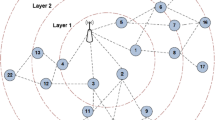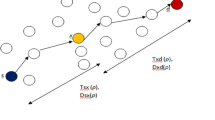Abstract
Using the available but limited resources of sensors more efficiently has been the recent interest in designing the routing protocols for Wireless Sensor Network (WSN). The major concern includes energy, storage and computing resources. Accordingly, we propose an adaptive energy-aware Multi-path routing protocol with load balance (AEMRP-LB). It introduces a concept named direction-angle to overcome the deficiency of broadcast and takes into account the tradeoff between the residual energy and hop count to establish multiple node-disjoint paths. The traffic load is balanced over the selected paths by using a weighted traffic scheduling algorithm considering their transmitting capacity, and then AEMRP-LB uses the advantages of Multi-path Source Routing to report the acquired data as saving the computing and storage resources of the sensors. In the scene with multiple Source-Sink pairs, AEMRP-LB can adaptively adjust the available residual energy of shared nodes so as to make reasonable use of them. The simulation results show that AEMRP-LB outperforms the two comparative schemes, and the sensors consume the energy in a more equitable way which ensures a more graceful degradation of service with time.
Similar content being viewed by others
References
Akyildiz, I. F., Su, W., Sankarasubramaniam, Y., & Cayirci, E. (2002). A survy on sensor networks. IEEE Communication Magazine (pp. 102–114).
Stankovic, J. A. (2008). Wireless sensor networks. Computer (pp. 92–95).
Pan, J., Hou, Y. T., Cai, L., Shi, Y., & Shen, S. X. (2003). Topology control for wireless sensor networks. In Proceedings of the 9th annual international conference on mobile computing and networking (MobiCom’03), September, 2003 (pp. 286–299). California, USA: San Diego.
Heinzelman, W. R., Chandrakasan, A., & Balakrishnan, H. (2000). Energy-efficient communication protocol for wireless microsensor networks. In Proceedings of the 33rd Hawaii international conference on system sciences (ICSS) 2000, (pp. 1–10).
Chao H. L., Chang C. L. (2008) A fault-tolerant routing protocol in wireless sensor networks. International Journal of Sensor Networks 3(1): 66–73
Jung, S., Lee, J., & Roh, B. (2008). An optimized node-disjoint multi-path routing protocol for multimedia data transmission over wireless sensor networks. In Proceedings of international symposium on parallel and distributed processing and applications (ISPA), December 2008, (pp. 958–963).
Shah, R. C., & Rabaey, J. M. (2002). Energy aware routing for low energy ad hoc sensor networks. In Proceedings of IEEE wireless communications & networking conference (WCNC) Vol. 1, March 2002, (pp. 350–355).
Lou, W., Liu, W., & Zhang, Y. (2006). Performance optimization using multipath routing in mobile ad hoc and wireless sensor networks. In Combinatorial optimization in communication networks, Vol. 18, 2006 (pp. 117–146). Springer.
Srinivas, A., & Modiano, E. (2003). Mininmum energy disjoint path routing in wireless ad hoc networks. In Proceedings of the annual international conference on mobile computing and networking (MobiCom), 14–19 September 2003, (pp. 122–133).
Zhai, Y., Yang, O. W. W., Wang, W., & Shu, Y. (2005). Implementing multipath source routing in a wireless ad hoc network testbed. In Proceedings of IEEE Pacific rim conference on communications, computers and signal processing (PACRIM), 2005, (pp. 292–295).
Nasipuri, A., & Das, S. (1999). On-demand multipath routing for mobile ad hoc networks. In Proceedings of international conference on computer communications and networks (IC3N), October 1999, (pp. 64–70). MA, USA: Boston.
Marina, M., & Das, S. (2001). On-demand multipath distance vector routing in ad hoc networks. In Proceedings of the ninth international conference for network protocols (ICNP), November 2001, (pp. 1–16). Riverside, CA, USA.
Yang Y., Zhong C., Sun Y., Yang J. (2010) Network coding based reliable disjoint and braided multipath routing for sensor networks. Journal of Network and Computer Applications 33: 422–432
Felemban E., Lee C. G., Ekici E. (2006) MMSPEED: Multipath multi-speed protocol for QoS guarantee of reliability and timeliness in wireless sensor networks. IEEE Transactions on mobile computing 5(6): 738–754
Huang X., Fang Y. (2008) Multiconstrained QoS multipath routing in wireless sensor networks. Wireless Networks 14(4): 465–478
Zytoune, O., El aroussi, M., & Aboutajdine, D. (2009). A uniform balancing energy routing protocol for wireless sensor networks. Wireless Personal Communications, doi:10.1007/s11277-009-9791-3.
Yin L., Wang C., Øien G. E. (2009) On the minimization of communication energy consumption of correlated sensor nodes. Wireless Personal Communications 50(1): 57–67
Lu, Y. M., & Wong, V. W. S. (2006). An energy-efficient multipath routing protocol for wireless sensor networks. IEEE Vehicular Technology Conference (VTC), Fall, 2006 (pp. 1–5).
Kim, M., Jeong, E., Bang, Y. C., Hwang, S., & Kim, B. (2008). Multipath energy-aware routing protocol in wireless sensor networks. In Proceedings of 5th international conference on networked sensing systems (pp. 127–130).
Minhas, M. R., Gopalakrishnan, S., & Leung, V. (2009). An online multipath routing algorithm for maximizing lifespan in wireless sensor networks. In Proceedings of the sixth international conference on information technology: New generations, 2008 (pp. 581–586).
Xu, Y., Heidemann, J., & Estrin, D. (2001). Geography-informed energy conservation for ad-hoc routing. In Proceedings of ACM/IEEE MobiCom’01, July 2001, (pp. 70–84). Rome, Italy.
Bejerano, Y., Han, S. J., Lee, K. T., & Kumar, A. (2008). Single-path routing for life time maximization in multi-hop wireless networks. In Proceedings of 33rd IEEE conference on local computer networks (LCN), (pp. 160–167).
Intanagonwiwat C., Govindan R., Estrin D. et al (2003) Directed diffusion for wireless sensor networking. IEEE/ACM Transactions on Networking 11(1): 2–16
Wu S., Candan K. S. (2007) Power-aware single- and multipath geopraphic routing in sensor networks. Ad Hoc Networks 5: 974–997
Cheng, W., Xing, K., Cheng, X., Lu, X., Lu, Z., & Su, J., et al. (2008). Route recovery in vertex-disjoint multipath routing for many-to-one sensor networks. In Proceedings of MobiHoc’08, May 2008, (pp. 209–219). Hong Kong SAR, China.
Author information
Authors and Affiliations
Corresponding author
Rights and permissions
About this article
Cite this article
Tao, M., Lu, D. & Yang, J. An Adaptive Energy-aware Multi-path Routing Protocol with Load Balance for Wireless Sensor Networks. Wireless Pers Commun 63, 823–846 (2012). https://doi.org/10.1007/s11277-010-0169-3
Published:
Issue Date:
DOI: https://doi.org/10.1007/s11277-010-0169-3




